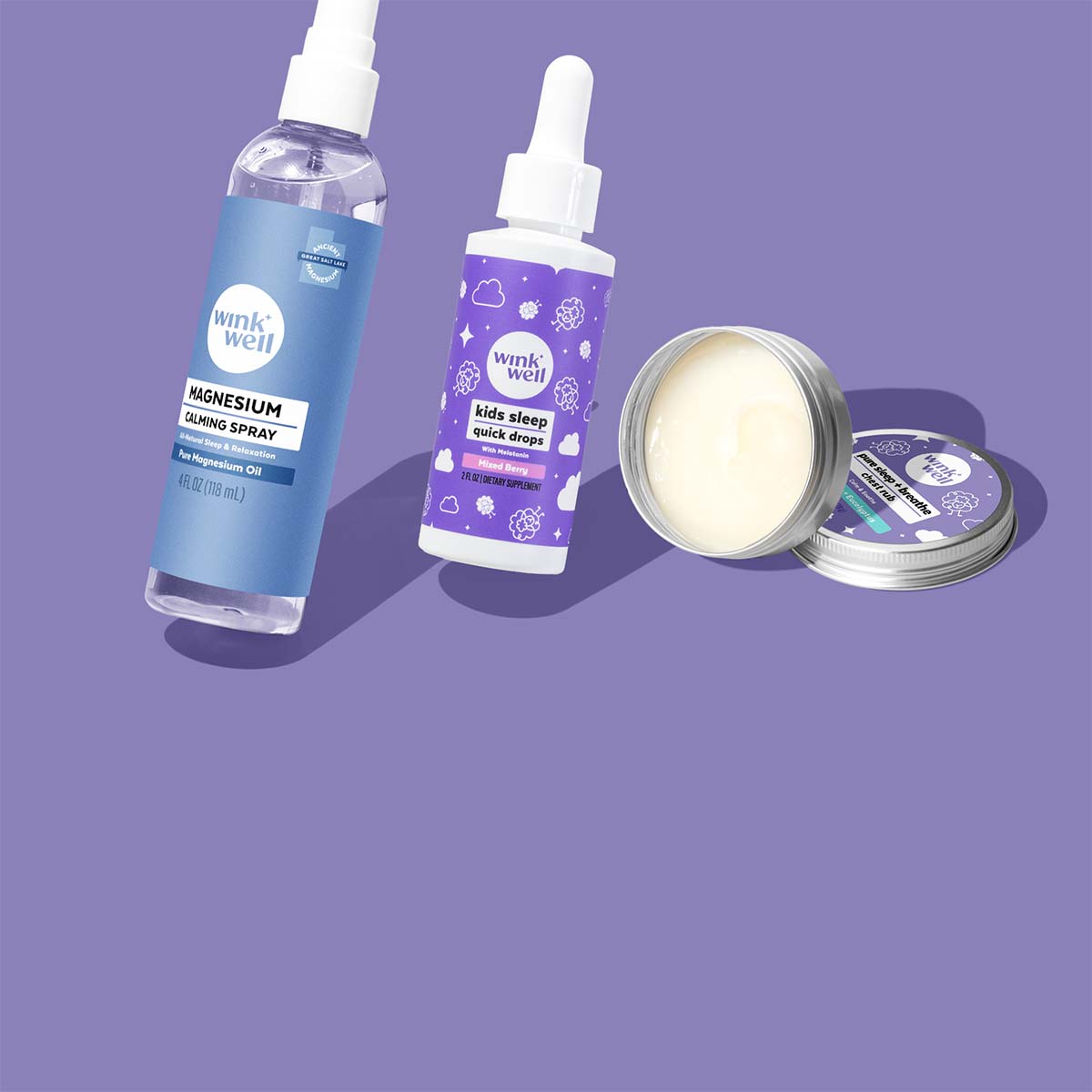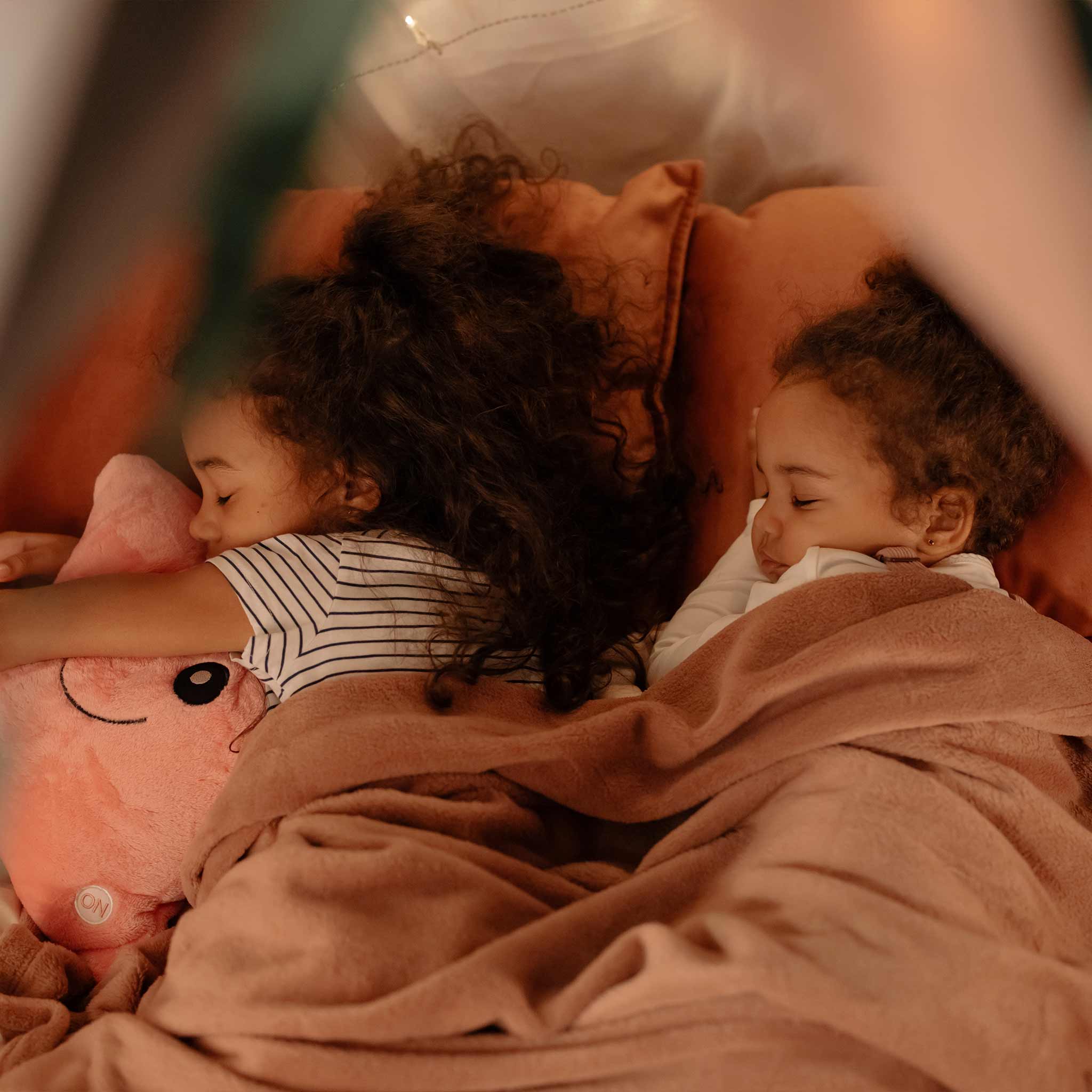When your kids sleep, you sleep. So let’s help you get more sleep!
Are you constantly battling your kids to go to sleep or stay asleep? You’re not alone. **Proper sleep plays a critical role in children’s development.** Everyone from infants to adults can benefit from quality sleep. Unfortunately, sometimes it is easier said than done. If you and your little one are struggling to get healthy sleep, take a look at our tips. Many fellow parents (including some of us at Wink!) have been there too.
Since 2008 we have been helping parents and children sleep without the use of drugs or harsh ingredients. We’ve created this sleep guide titled 7 Steps to Perfect Sleep for Toddlers. We guarantee if you follow these steps consistently, and are patient, this will help your toddler sleep in their own bed and you will sleep more.
Step 1. Establish How Much sleep your toddler needs.
- Look at Wake Windows. Toddler years are from the ages of 1 to 3 years. As your child grows, their wake windows and the total amount of needed sleep will change. That means the number of naps during the day and the overall length of daytime sleep will adjust as they grow. This is the same for nighttime sleep as well. Take a look at this wake windows chart to get an idea of how much sleep your child needs.
- Find the sweet spot for your toddler. After looking at the wake windows, find that sweet spot for your toddler. There will be a perfect combination of daytime sleep and bedtime that will help your toddler thrive. While staying within this “sweet spot” won’t always happen, stick to it as closely as you can to see the best results. Keep in mind, toddlers are not like adults. For adults, the later we stay up can result in us sleeping longer the next morning. This is not the case for our kiddos. Putting them to bed later won’t necessarily make an impact on how long they sleep the next day. In fact, overtired toddlers who stay up later usually have more night wakings and early mornings. Most toddlers thrive with a bedtime between 6:30-8 pm.

Step 2. Create a routine with a Sleep Plan.
Now that you have found your sweet spot, let's create your sleep plan. At this point, you know how many naps your little one should take and ideally how long each of those naps should be. We also know, based on that last nap time, what your toddler's ideal bedtime is. Creating a plan gives you an outline to follow and a step-by-step routine to repeat every night for bedtime. Toddlers feel safe when they have structure and boundaries even if they fight bedtime. If things are unpredictable, it can lead to confusion and big emotions. This is a plan that you can physically write and map out (with pictures) for your toddler to see. Doing this gives them a chance to visualize the plan and know what part is coming up next. Simplify the plan as needed to fit for your child’s needs, and start going through it nightly. You will want to ensure there is nothing in the plan that makes your child rely on you for bedtime.. Examples of this are: back rubs to fall asleep, laying with them until they fall asleep, etc.
Never had a routine before? Here is a solid routine that you can adapt and adjust to fit your toddler.
- Spend one-on-one time with your toddler during the day. Doing this, especially if you have multiple children, can be a game changer for your toddler. Connecting with them during the day can help them feel safe and comfortable at night. This is helpful to avoid them seeking connection with you during those early night hours. Even if you are around your toddler all day it doesn’t necessarily mean you are connected with them. Do it every day! Choose a time that allows you to fully commit to your toddler for at least 10 minutes. This means phones down, no multitasking, just one on one time. They need your undivided attention.
- Start with a set dinner time. We know life gets crazy and having dinner at the same time every night might not always be possible. Establishing a consistent mealtime schedule is important in helping your child develop healthy eating habits, such as knowing when their tummy is full and how to enjoy family meals. The goal is to try to keep meals and snacks scheduled around the same time each day, but don’t stress if it’s not exact. Sit down to eat, preferably all together. Remove distractions like TV and cell phones so your family can focus on eating. This will ensure that your toddler has a full belly and isn’t going to wake up during the night because they are hungry. It will also help your toddler get into the habit of eating dinner and knowing they will be winding down for the rest of their bedtime routine soon after.
- Do a nightly bath. Your temperature increases before waking up, stays high through the day as you move around, and drops in the evening as a signal to sleep. Including a bedtime bath will help promote this process and give the right signals to the body to sleep. As part of bathtime, using a good quality bath wash that can also promote sleep is key. Wink’s Foaming Oil Bath Wash is made with Citrus and Lavender Oils to calm and soothe before bedtime. This wash is free from sodium lauryl sulfate (SLS), harsh chemicals, or surfactants.
- Finish any and all bathroom needs. After the bath, finish any additional routines that you need. This could include brushing teeth, flossing, and combing hair. Keep your toddler in the bathroom until those are finished so once you leave the bathroom and head to their bedroom you won’t have to worry about leaving again. This will be helpful to them as well because they will know what goes next in their nightly sleep routine.
- Use a calming lotion for a simple massage. Regular massages have been shown to help to get circadian rhythms on track. This will help them be calm so they sleep more at night and be more active during the day. With the massage using a good lotion that promotes calmness is an added benefit. Wink created the perfect lotion to add to your bedtime routine. Llama lotion is scented with real, natural citrus and lavender oils. Lavender is extremely helpful and promotes sleep.
- Use extra protection for diaper changes before nighttime. If your child is still in diapers they should be getting a protective coat on their bums before putting on their diapers for 10+ hours. Wink’s Bum Balm provides the best moisture barrier with non-Nanoparticle zinc oxide. It is thicker and creamier than other balms so it stays where you put it, plus it is non-greasy and not petroleum-based. This will help to keep them comfortable all night long and prevent diaper rashes from developing. When toddlers wake up wet and cold they will certainly not want to go back to sleep.
- Breathe easy and apply Chest Rub. Just like the bath wash and lotion, Wink’s Pure Sleep and Breathe Chest Rub promotes calming and soothing that is essential for preparing for bed. When you are doing these steps you might feel like they are a bit excessive, but think about how busy and active your toddler is during the day. They need time to ensure they are winding down completely and you are promoting sleep as much as possible. Stick with it!
- Get dressed for bed. Dressing your toddler for sleep is a good way to make sure they are comfortable during the night and avoid getting too hot or too cold. A good rule of thumb is to dress your toddler like you are dressed. An example would be if you wear one layer of clothing and then have 2 blankets, dress your child in a onesie, pajamas, and sleep sac therefore you both have 3 layers. Access their temperature by touching the back of their neck. Give them two choices of pajamas (that you approve of) and allow them a chance to decide and be involved. Their room should be slightly cool at bedtime. Not cold and not hot.
- Reading time. Next up, read a book or two… or three! You can let them choose this as it helps them feel part of the plan. Be consistent with how many you read each night so your toddler knows what to expect and when it will be time for you to leave the room. Reading has endless benefits for your toddler including contributing to your child’s brain development. Research has shown that reading to even your baby instills learning and development in addition to preparing them for bedtime.
- Lights out! Give them a countdown (you could set a timer) and then finish out the bedtime routine with hugs, kisses, words of comfort, etc. before you turn off the lights and shut the door. If you choose to have a night light in their room, make sure it is not within direct eye shot of them. Direct light can stimulate them to stay up and prevent sleeping. A small ambient light is ok but darker is always better. With kids in toddler beds try using a light that is red or orange. A red night light won't interfere with their circadian rhythm and melatonin production and they will see it as a calming, soothing, familiar environment.
Step 3. Food Matters!
There are foods that should be avoided and foods that should be eaten to promote a good night's sleep. Let’s start with what to avoid.
Foods to avoid.
- Caffeine. This might seem obvious, you should avoid soda and anything like that, but caffeine can be found in foods such as chocolate and granola bars. Avoiding this before bed will help your child be able to wind down.
- Tyramine. This is found in lots of foods. Foods rich in tyramine are ham, pepperoni, bacon, avocado, soy sauce, raspberries, and aged cheese. While many little ones crave cheese at all times of the day, it is actually better to stay away from aged or strong cheese before bedtime. This is because aged cheese is rich, and the other foods listed are rich in tyramine, which causes brain stimulants to be released, making your little ones alert and wide awake.
- Cruciferous vegetables. According to research, some veggies are better for lunch than for dinner. Cruciferous veggies, like cauliflower, broccoli, spinach, cabbage, greens, radishes, and brussels sprouts are full of tough fibers that are very good for the body, but not the best at night time. The digestion of high-fiber meals raises our body temperature and good sleep requires cooler temperatures. This clash can lead to a fitful sleep.
- Spicy Food. Food that is extremely spicy can trigger digestion problems in children. Along with indigestion or frequent stools, stomach irritation can cause temporary insomnia in kids. Avoid spicy foods especially if you do not have them in your home often.
- Sugars and sweets. Too much sugar isn’t beneficial, whether it is during the day or at night. Sugary food (like desserts, sodas, and candies) sends our blood sugar to a spiking high. When it comes crashing down a few hours later, your body goes into fight or flight thinking there’s an emergency. This flooding of adrenal cortisol can interfere with sleep and leave your little one wide awake at the darkest hours.
- Saturated and trans fats and salty meals. A full-fat meal is a wonderful nourishment for growing kids, if it's the right type of fats! Foods containing saturated and trans fats are primarily in processed foods which are not recommended right before bed. On that same note, it is always advisable to finish your largest meal 2 to 3 hours before bedtime. Keep that in mind as you create a set dinner time each night. The time at which we eat our meals has a significant effect on our health. Hitting the bed right after a meal is also a major cause of heartburn and acid reflux, some of the biggest sleep disruptors.
Foods to eat.
- Dairy products. Yogurt and milk are great sources of calcium which contains the amino acid tryptophan. While not sleep-inducing itself, our bodies use tryptophan to make the neurotransmitter serotonin, which promotes feelings of calmness and sleep; as well as the sleep hormone melatonin. There is some truth to the old wive’s tale: A glass of warm milk before bed sports these benefits, as well as the additional soothing effect of a warm tummy.
- Whole grains. Complex carbohydrates such as those found in 100% whole grain bread and crackers are great snacks. This type of carb processes more slowly than its simple counterpart (found in sweets and white bread), which avoids sharp increases and dips in blood sugar to avoid nighttime awakenings.
- Nut Butters. Turn to all-natural nut butter for a healthy source of protein at bedtime. While all nuts boast a high concentration of tryptophan, choosing certain varieties will pack extra benefits. For example, walnuts have an additional source of melatonin; and almonds contain magnesium which helps muscles relax.
Keep in mind, nut butter is usually sweetened. Avoid the ones with added sugar so their blood sugar does not spike and dip throughout the night.
- Fruits. Fruits make a great addition to any snack, but choose the right ones before bed for an extra sleepy boost. Apples and bananas are rich in magnesium and potassium which promote muscle relaxation. Bananas come with additional benefits, providing an extra source of tryptophan which your body will synthesize into serotonin and melatonin. Another great evening fruit: Cherries! They have been proven to increase melatonin levels and promote sleep.
7 bedtime snacks that help toddlers sleep:
- Nut butter on whole-grain toast or crackers
- An apple with nut butter (no sugar added).
- Plain yogurt with fresh fruit.
- A Banana with peanut butter (no sugar added).
- A warm glass of milk with whole-grain toast.
- Honey on toast.
- Cherry smoothie with milk and honey.

Step 4. Determine why they aren’t sleeping.
If your toddler isn’t sleeping it most likely comes down to 3 main reasons.
- Stomach Discomfort. Toddlers are in a constant state of change during the 1-3 year time period. They are eating new foods, teething, growing, and mentally developing rapidly. These changes can definitely disrupt sleep. You need to try and identify where the discomfort is so you know how to help. If your toddler is having trouble with regular bowel movements or having too many bowel movements they are probably having Gastro Intestinal Discomfort. An upset stomach is not easy to fall asleep or stay asleep with. Every toddler can benefit from taking the right kind of probiotics. Wink’s Pre & Pro Biotic has amazing benefits that can do so much for them! Our probiotic melt improves digestion and gut health*, probiotic reduces irritation in the GI tract*, and promotes regular bowel habits* to name a few.
- Teething. The whole teething process can make sleep even harder. Don’t worry we can help! Teething pain usually only lasts 24-72 hours per tooth. There are several things you can do to help them during this time. First, Cool Gums Teething Gel. Wink created a gel specifically for your little ones that is designed to cool and soothe, not numb.* It is very important to note that any type of numbing is not safe. This doctor-developed formula is natural and 100% drug-free. It does not contain harmful ingredients like belladonna or benzocaine. It also doesn’t contain clove oil or lidocaine, or anything else potentially toxic and harmful to babies and children). Next, try something cold. Something cold: This could be a cloth, silicone teething ring (put in the fridge only), frozen purees, or frozen waffles. Massage: Using a clean finger to gently massage the gums for up to one minute can help relieve discomfort. Warm Bath. Draw a warm bath for your little one. The warm water can soothe their body and provide a fun distraction from the discomfort they are feeling. (Want more help with Teething? Download our FREE teething guide here.)
- Blue light exposure. Too much exposure to blue light at night (through smartphones, tablets, and computers) can disturb the wake and sleep cycle, leading to problems sleeping and daytime tiredness. High levels of blue light exposure can affect mental health in children by messing with the body's natural rhythms and stimulating the brain. Blue light exposure at night has a significant negative impact on children's sleeping habits, and poor sleep is associated with changes in mood. Combat this by creating strict guidelines for screen time. No screens for your toddler for at least the two hours before bedtime. Keeping this boundary will help their natural rhythms stay in check.
- Inconsistency in routines/sleep cycle is off. Toddlers flourish with routines. They do well knowing what to expect and having consistency. Maybe, up to this point you haven’t been great with consistency or you haven’t created a routine. That's ok! Start now. Create your sleep plan and stick to it! This will do wonders for you, your toddler, and their sleep habits. When they sleep, you’ll sleep too. Or if you struggle with your own sleep beyond being woken up by your toddler, Wink has an Adult Sleep Melt that can help. Toddlers who struggle with sleep will test your patience, but we promise creating a solid plan and holding firm will give you and your toddler the best outcome possible.
- Growing Pains, muscle soreness. As your child grows, their bones and muscles become tired, fatigued and can cause pain. Usually this happens at night or in the afternoon. They may say their bones hurt or their legs feel funny. This sensation can be painful and is oftentimes short lived. Applying a heating pad and a gentle massage can help with this discomfort.
Step 5. What products to avoid?
- Weighted blankets. Weighted blankets might be a great asset for adults, but they are not for toddlers. Avoid weighted blankets for children. A weighted blanket can be especially risky to a baby or toddler, as the excess weight could cause the baby to get trapped underneath the blanket causing suffocation or entanglement. In addition if the blanket made its way to the baby's face, it could pose a suffocation risk as well.
- Space Heaters. It may be tempting to just heat up your little one's room, rather than the whole house, but they are not safe. Using a space heater could lead to your little one overheating. Space heaters can also cause fires and can cause surface burns to small children. If your toddler is in a big kid bed, it is especially not safe to have anything in the room that could cause them harm.
- Avoid Co-Sleeping. Co-sleeping is off limits for various reasons. Co-sleeping increases the risk of sudden infant death syndrome. Parents or objects (like pillows or blankets) may unknowingly roll onto the toddler at night, leading to injury, suffocation, or death. The American Academy of Pediatrics warns parents against 'co-sleeping' with infants. The safest place for an infant to sleep is in a crib or bassinet next to their parents' bed.
- Avoid blue light syndrome, gaming, tv, tablets. Blue light is the light emitted from screens like a TV, phone, tablet. Blue light is known to stimulate and trick the brain into thinking it is daytime and works against your body’s sleep cycle. As mentioned above, blue light can be very harmful for little children, even more so right before bedtime. This can disturb the sleep wake cycle and make nights even more difficult. The main concern with blue light from screens is the close proximity of the screens (especially computers, phones, tablets) and the length of time looking at them. Do your best to avoid screens 2 hours prior to bedtime.
- Avoid caffeine, sugary sweets, drinks, or drinking too much before bedtime. For the best results, avoid giving your child sugar before bedtime. Their tiny bodies will be hard at work to re-stabilize their blood sugar and, in doing so, will release adrenaline, a stress hormone, which can cause toddlers to experience restlessness. This, in turn, can have a major effect on their sleep. It can lead to nightmares, vivid dreams and overall poor sleep. In addition, drinking too much before bedtime can force them to wake up to use the bathroom and they might have a hard time going back to sleep after that.
Step 6. Use these Soothing and Calming products.
- Llama Lotion after bath. Llama lotion is gentle and safe for ALL ages and skin types, including sensitive skin. It provides natural relief from symptoms associated with dry, itchy skin and promotes calming and soothing through essential oils. Llama Lotion is paraben-free, artificial fragrance and dye-free. It has added moisturizing benefits of coconut oil and jojoba extract. Using this before bed helps your toddlers brain associate the lavender lotion with sleep. Rubbing lotion on them can help relax their little bodies and prepare them to have a good night's sleep.
- Pure Sleep and Breathe Chest rub to sleep train and for breathing. Chest Rub is made with coconut oil, shea butter, and natural oils. It is petroleum/paraben free (no harsh chemicals or skin irritants). The lavender and eucalyptus oils paired together promote calmness, relaxation and cozy sleep. It is a great addition to your bedtime routine to add an extra dose of calm. Additionally, chest rub helps to promote open airways and easy breathing. This is a great product to use nightly and especially if your little one is feeling any type of sickness. Apply it to their chest, back and bottom of feet.
- Teething Gel for cutting teeth. Help soothe your little one with Cool Gums Teething Gel. Teething is tough! Your little one will definitely need some extra love when they are teething. You can help soothe them by cooling (NOT numbing) their little gums with this gel. (Pro Tip: Keep it in the fridge for a little extra cool). If you want more information on teething check out our FREE Teething Guide here.
- Sleep Drops and Sleep Melts. The drops and melts were designed to promote safe sleep. There can be a lot of confusion surrounding melatonin and the impact it has on children. Sleep Melts and Drops are non-addictive and non-habit forming*. With melatonin naturally being produced in the body, we feel it’s a great natural sleep aid.
- Zen Drops for Relaxation. Zen Drops are clinically proven to help reduce stress and racing thoughts by working with your body to increase GABA in the brain. They are drug free and made with passion flower extract. They won’t make you or your child groggy but they do help with relaxation prior to sleep. They are safe for ages 3 years+.
Step 7. Patience and Consistency is key!
You did it! You’re at the end, and you are doing a great job mama! We know those sleepless nights can wear on you! We see you pushing through and doing all you can for your little ones. We have been there and we guarantee that if you follow these steps for 30 days, you will see results and sleep better. Consistency and patience are the key to being successful. We all know toddlers can be defiant and push boundaries, but kids need consistent routines even when they fight it. Create your sleep plan and stick with it. There will be times when this plan is disrupted but as soon as you can go right back to that routine.
And remember, you are not alone! We’re here to help! If you have any questions, please call us, we will be happy to answer any questions for you. 1-888-799-5656.
Still have questions? Let us know!







Leave a comment
All comments are moderated before being published.
This site is protected by hCaptcha and the hCaptcha Privacy Policy and Terms of Service apply.